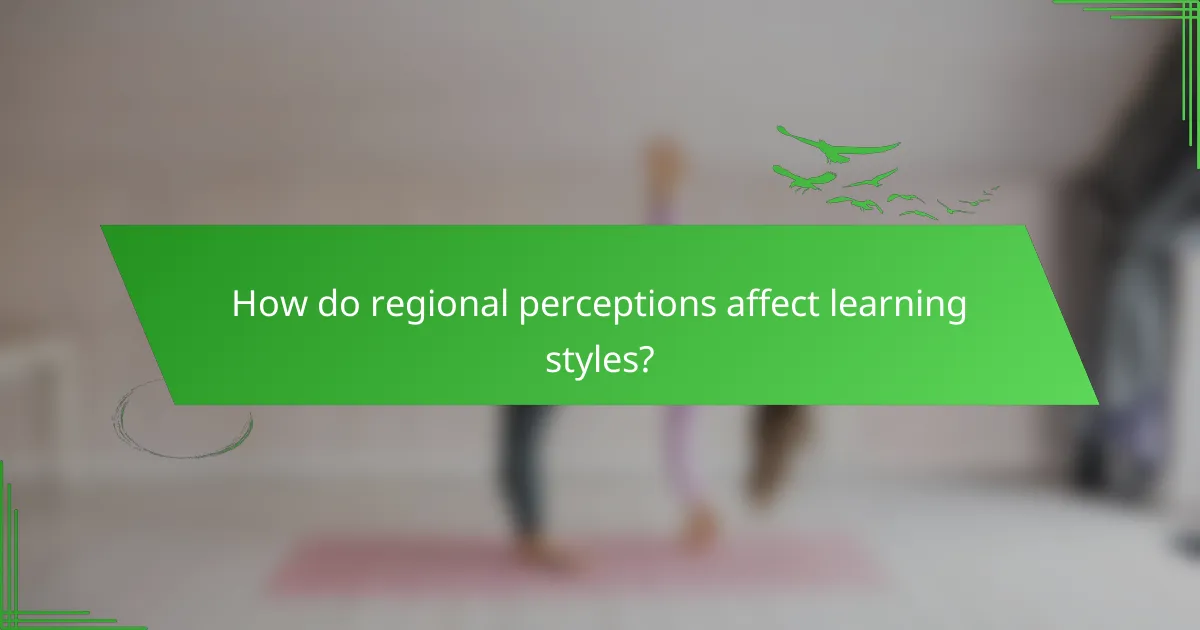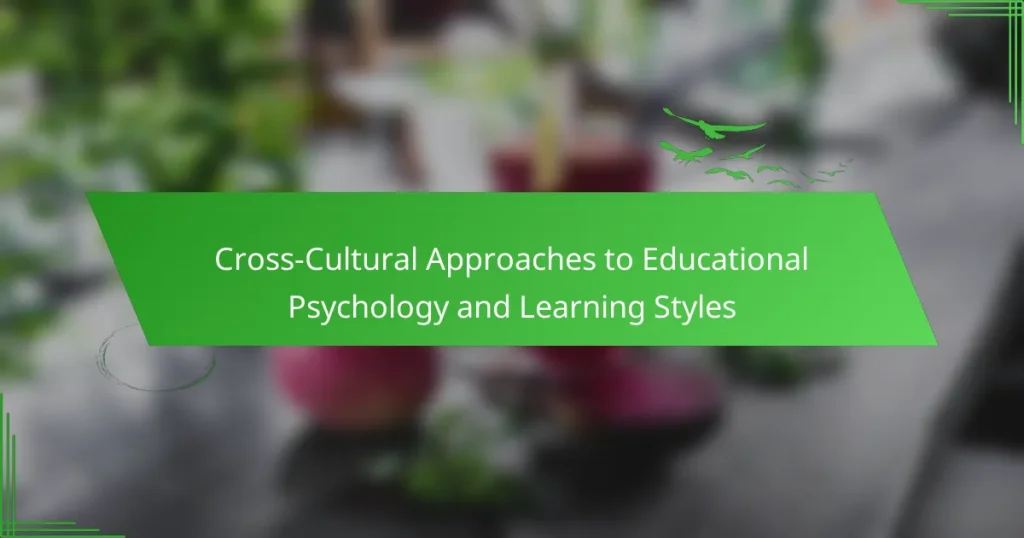Understanding cross-cultural approaches to educational psychology is essential for effective teaching. This article explores the influence of cultural contexts on learning styles, highlights shared attributes like adaptability and inclusivity, examines unique cultural values and communication styles, and discusses the impact of regional perceptions on educational outcomes. Implementing culturally responsive teaching practices can enhance engagement and comprehension among diverse learners.

What are the foundational concepts of educational psychology?
Cross-cultural approaches to educational psychology emphasize the influence of cultural contexts on learning styles. These concepts highlight that educational practices and psychological theories must consider cultural diversity to be effective. For example, collectivist cultures often prioritize group learning, while individualistic cultures may focus on personal achievement. Understanding these differences is crucial for developing inclusive educational strategies. Additionally, unique attributes such as language and social norms play a significant role in shaping learning experiences across different cultures.
How do cultural contexts influence learning theories?
Cultural contexts significantly shape learning theories by influencing how knowledge is perceived and transmitted. For instance, collectivist cultures often emphasize group learning and social interaction, while individualistic cultures may prioritize personal achievement and autonomy.
Cultural values dictate preferred learning styles, affecting engagement and retention. In some cultures, oral traditions are prominent, leading to storytelling as a primary learning method, whereas others may favor written texts and formal instruction.
Additionally, cultural contexts impact motivation and educational expectations. For example, cultures that value academic success may foster a competitive learning environment, while others may encourage collaboration and support among peers.
Understanding these influences allows educators to tailor approaches that respect cultural differences, enhancing the effectiveness of educational psychology and promoting diverse learning styles.
What are the primary learning styles recognized globally?
The primary learning styles recognized globally include visual, auditory, and kinesthetic. Visual learners prefer diagrams and charts, auditory learners benefit from listening, and kinesthetic learners learn best through hands-on activities. Each style influences educational approaches across cultures, reflecting unique cognitive preferences.

What universal attributes define cross-cultural approaches?
Cross-cultural approaches in educational psychology emphasize shared attributes such as cultural sensitivity, adaptability, and inclusivity. These attributes foster effective learning environments by acknowledging diverse perspectives and learning styles. Cultural sensitivity ensures awareness of different cultural backgrounds, while adaptability allows educators to modify teaching methods. Inclusivity creates supportive spaces for all learners, enhancing engagement and comprehension.
How does cultural diversity impact educational psychology?
Cultural diversity significantly enriches educational psychology by influencing learning styles and teaching methods. It fosters a more inclusive environment that acknowledges varied perspectives, enhancing student engagement and understanding.
Diverse cultural backgrounds shape cognitive processes and emotional responses, leading to unique learning preferences. For instance, collectivist cultures may prioritize group learning, while individualistic cultures may favor independent study. This variation necessitates adaptive teaching strategies to accommodate all learners effectively.
Moreover, cultural diversity promotes critical thinking and creativity. Exposure to different viewpoints encourages students to analyze information from multiple angles, fostering a deeper comprehension of subject matter. Educators can leverage this diversity to create dynamic classroom discussions that benefit all students.
Incorporating cultural diversity in educational psychology not only supports academic success but also prepares students for a globalized society. Understanding these dynamics is essential for educators aiming to create equitable learning environments.
What are the common learning styles across different cultures?
Common learning styles across different cultures include visual, auditory, and kinesthetic approaches, each influenced by cultural context. Visual learners benefit from diagrams and charts, while auditory learners grasp concepts through discussions. Kinesthetic learners thrive on hands-on activities. Cultural factors shape preferences, leading to unique educational practices globally. For instance, collectivist cultures may emphasize collaborative learning, whereas individualistic cultures often promote independent study. Understanding these variations enhances cross-cultural educational strategies.
How do visual, auditory, and kinesthetic styles manifest globally?
Visual, auditory, and kinesthetic learning styles manifest globally through distinct cultural adaptations. Visual learners thrive in environments that emphasize imagery and visual aids, common in cultures valuing art and design. Auditory learners benefit from oral traditions and storytelling, prevalent in societies with strong verbal communication. Kinesthetic learners engage best through hands-on experiences, often emphasized in cultures that prioritize physical activity and practical skills. These manifestations reflect unique educational values and approaches across different regions, influencing teaching methods and learning outcomes.
What role does socio-economic status play in learning preferences?
Socio-economic status significantly influences learning preferences by affecting access to resources and educational opportunities. Higher socio-economic status often correlates with a greater availability of learning materials and extracurricular support. Conversely, lower socio-economic status may limit exposure to diverse learning experiences, impacting motivation and engagement. Studies indicate that students from varied socio-economic backgrounds exhibit distinct preferences for collaborative versus independent learning, highlighting the importance of tailoring educational approaches to meet these needs. Understanding these dynamics can enhance educational strategies in diverse cultural contexts.

What unique attributes distinguish specific cultural approaches?
Cultural approaches to educational psychology are distinguished by unique attributes such as values, social norms, and communication styles. For instance, collectivist cultures emphasize group harmony and collaboration, while individualist cultures prioritize personal achievement and autonomy. Additionally, some cultures may integrate holistic approaches to learning, valuing emotional and spiritual dimensions alongside cognitive development. These distinctions influence teaching methods, curriculum design, and student engagement strategies, highlighting the importance of context in educational psychology.
How do indigenous learning practices differ from mainstream methods?
Indigenous learning practices emphasize experiential, community-based methods, contrasting with mainstream approaches that prioritize standardized testing and individual achievement. Indigenous education values holistic development, integrating cultural traditions and communal knowledge. This contrasts with the often linear, compartmentalized structure of mainstream education. Additionally, indigenous methods foster relational learning through storytelling and mentorship, while mainstream methods typically focus on formal instruction and curriculum. These differences highlight the unique attributes of indigenous learning, which prioritize cultural identity and community engagement.
What unique educational frameworks exist in various regions?
Various regions implement unique educational frameworks that reflect their cultural values and learning styles. For instance, Finland emphasizes student autonomy and holistic development, while Japan focuses on group harmony and discipline in learning.
In the United States, diverse pedagogical approaches cater to varied learning styles, integrating technology and experiential learning. Meanwhile, in India, traditional methods coexist with modern practices, highlighting rote learning alongside critical thinking.
These frameworks illustrate how cultural context shapes educational psychology and influences learner engagement. Understanding these differences enhances cross-cultural educational strategies.
How does the Montessori method adapt to different cultural settings?
The Montessori method adapts to different cultural settings by emphasizing respect for individual learning styles and local values. This approach allows educators to tailor the learning environment to reflect cultural norms and practices. For instance, materials and activities can incorporate local languages and traditions, enhancing relevance and engagement. Additionally, the method’s focus on independence and self-directed learning aligns with various cultural perspectives on education, fostering a sense of ownership among students. This adaptability is a unique attribute of the Montessori approach, making it effective across diverse contexts.
What are the unique aspects of Vygotsky’s theories in diverse contexts?
Vygotsky’s theories emphasize the role of social interaction and cultural context in learning. His concept of the Zone of Proximal Development highlights how learners progress with guidance. Unique aspects include the emphasis on language as a tool for thought and the importance of cultural tools in shaping cognitive development. These theories adapt well across diverse educational settings, reflecting various learning styles influenced by cultural backgrounds.

What rare attributes can be observed in educational psychology?
Rare attributes observed in educational psychology include culturally specific learning preferences, non-verbal communication styles, and unique motivational factors influenced by cultural contexts. These attributes can significantly impact teaching effectiveness and student engagement across diverse populations. For example, some cultures may prioritize collaborative learning, while others emphasize individual achievement. Understanding these rare attributes enhances cross-cultural educational strategies and promotes inclusive learning environments.
What uncommon learning styles are recognized in specific cultures?
Uncommon learning styles recognized in specific cultures include kinesthetic learning in indigenous tribes, holistic learning in Eastern cultures, and communal learning in African societies. These styles emphasize physical engagement, interconnectedness, and collaborative methods. For example, indigenous tribes often incorporate storytelling and hands-on activities, while Eastern cultures may focus on group harmony and collective understanding.
How do historical events shape educational practices in certain regions?
Historical events significantly influence educational practices by shaping cultural values and learning styles in specific regions. For example, post-colonial societies often adopt educational systems that reflect their historical experiences, emphasizing local languages and traditions. Additionally, regions affected by war may prioritize trauma-informed educational approaches, acknowledging the psychological impact of conflict. Historical events can also create unique attributes in educational frameworks, such as the integration of indigenous knowledge in curricula. As a result, educational psychology adapts to reflect these diverse cultural contexts, promoting cross-cultural understanding and tailored learning experiences.

How do regional perceptions affect learning styles?
Regional perceptions significantly influence learning styles by shaping preferences and approaches to education. Cultural values, social norms, and language impact how individuals learn and engage with material. For instance, collectivist societies may prioritize group learning, while individualistic cultures might emphasize personal achievement. This variation highlights unique attributes of learning styles across different regions, affecting educational outcomes. Understanding these perceptions allows educators to tailor their methods to better suit diverse learners, enhancing overall effectiveness.
What are the prevalent challenges faced in cross-cultural education?
Cross-cultural education faces challenges such as language barriers, cultural misunderstandings, differing educational expectations, and varying learning styles. These issues can hinder effective communication and collaboration among students and educators from diverse backgrounds. Additionally, educators may struggle to adapt teaching methods to accommodate unique cultural perspectives, which can impact student engagement and learning outcomes.
How do educators adapt teaching methods to local cultural norms?
Educators adapt teaching methods to local cultural norms by integrating culturally relevant materials and practices. They consider students’ backgrounds, values, and learning preferences, which enhances engagement and understanding. For example, using storytelling in cultures that value oral traditions can improve retention. Additionally, collaborative learning aligns with collectivist cultures, fostering teamwork and shared responsibility. This approach respects local customs while promoting effective learning.

What best practices can enhance cross-cultural educational psychology?
To enhance cross-cultural educational psychology, implement culturally responsive teaching practices. These practices recognize diverse learning styles and foster inclusivity.
1. Understand cultural backgrounds to tailor educational approaches.
2. Incorporate diverse teaching materials reflecting various cultures.
3. Encourage collaborative learning to build cross-cultural understanding.
4. Provide training for educators on cultural competence.
5. Adapt assessment methods to accommodate different cultural contexts.
What strategies can educators employ to cater to diverse learning styles?
Educators can employ various strategies to cater to diverse learning styles by incorporating differentiated instruction, collaborative learning, and technology integration. Differentiated instruction involves tailoring lessons to meet individual needs, allowing students to engage with material in ways that suit their learning preferences. Collaborative learning encourages peer-to-peer interaction, fostering a supportive environment where students can learn from each other’s strengths. Technology integration, such as using multimedia resources, can address visual, auditory, and kinesthetic learning styles effectively. These approaches create a more inclusive educational experience that recognizes and values the unique attributes of each learner.
What common mistakes should be avoided in cross-cultural teaching?
Common mistakes in cross-cultural teaching include assuming homogeneity among students, neglecting cultural context, and failing to adapt teaching methods. Misunderstanding communication styles can lead to disengagement. Ignoring students’ cultural backgrounds may hinder their learning experiences. Additionally, not fostering an inclusive environment can alienate diverse learners.
How can educators optimize learning experiences for all students?
Educators can optimize learning experiences for all students by embracing cross-cultural approaches that acknowledge diverse learning styles. Understanding variations in cultural backgrounds allows educators to tailor their methods, enhancing engagement and retention.
Incorporating strategies such as culturally relevant pedagogy fosters inclusivity. For example, integrating students’ cultural contexts into lessons can make learning more relatable. Research shows that students perform better when their cultural identities are recognized and valued.
Additionally, utilizing varied instructional methods caters to different learning preferences. This includes visual aids for visual learners, discussions for auditory learners, and hands-on activities for kinesthetic learners. By offering multiple pathways to knowledge, educators can reach all students effectively.
Finally, continuous professional development in cultural competence equips educators with the skills to address diverse needs. This commitment to understanding and adapting to student differences is essential for creating an equitable learning environment.




